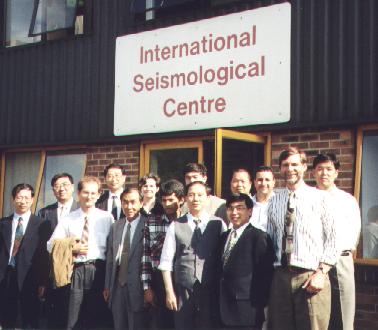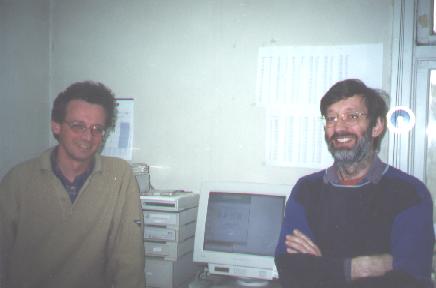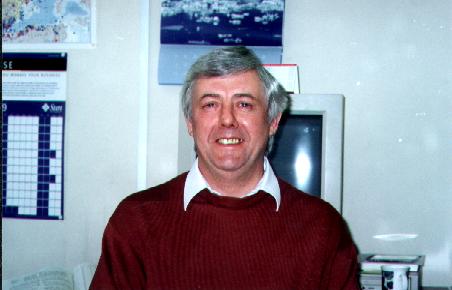

 |
 |
Prof Chen Zhangli, Director-General of the China Seismological Bureau, headed a delegation that visited the ISC in June. Ray Willemann and Dmitry Storchak told the delegation about the ISC and its Bulletin, then led them on a tour of the Centre, with opportunities to discuss the ISC's modernisation programme with computer staff and bulletin analysis with seismologists. After lunch at a local pub, Prof Zhangli a gave a presentation about CSB programmes, including an upgrade and expansion of the Chinese national network of broadband seismic stations. Plans for improved exchange of data and information were discussed, including the possibility of an extended visit to the ISC by CSB staff. Prof Zhangli explained that CSB seismologists are dedicated to contributing to global seismology, and expressed support for the ISC's work in assembling a global seismic bulletin. Ray Willemann and He Qin, Chief Executive Officer of the CSB Department of International Cooperation, made arrangements to ensure that Mr He's department stays up to date on all activities of the ISC.
The UK Royal Society has completed a thorough review of the ISC's contribution to earth science, especially in Britain. Based on a conclusion that the ISC's work is valuable and important, the Royal Society committed itself in May to continue funding at the current level for three years. The Society encouraged the ISC to consider joint projects with universities while continuing to place priority on its basic mission of producing the Bulletin.
Senior Seismologist Dmitry Storchak put his first full year of ISC earthquakes to bed in May when analysis of December 1996 earthquakes was completed. The data for 1996, 1.5 million readings associated with more than 65 thousand events, was second in number only to 1995. For earthquakes in 1996, treatment of data from the EIDC was changed to comprehensively represent its contribution to global seismic monitoring.
For this year the ISC changed the way it uses data from the EIDC REB, which is one of our two largest data providers. Starting with earthquakes in 1996, we include all events and all station readings from the REB, regardless of the number of stations supporting an event.
REB hypocentres are computed differently from those of the ISC. The EIDC uses
Many EIDC epicentres are computed using only a few seismic readings, and epicentral uncertainties may be large. Partly because ISC does not use PKP times or slowness and azimuth, we could not compute our own epicentre for some of these events. Even so, we associated additional station data, even with travel-time residuals as large as 60 seconds, since users may want to recompute locations with another travel time model or more data.
IASP91 phase identification, used in the REB, differs from JB identifications used by the ISC. The JB tables exclude Pg arrivals beyond 8 degrees, for example, and don't include PKiKP at all. If a non-JB phase is the first in a station reading, the "ISC phase identification" will have very little to do with an ISC editor's true opinion. As with the large residuals, we intended to keep readings associated with the appropriate event rather than exclude them from the Bulletin, even at the cost of apparent inaccuracy.
Another important issue is that with the introduction of the REB, the ISC Bulletin now includes readings made by different agencies from the same waveforms. Examples include WRA, ASAR, GERES, NORESS, MJAR and YKA. Currently both EIDC and station operator readings are used for ISC location. We plan address the issue of duplicate readings in the near future, probably continuing to exclude duplicate reports of a reading but publishing independent readings while using only one of them to compute a location.
The ISC has always accepted new data from all over the world. In the last few years, we have been able to begin collecting data from a few regions where the networks presently reporting to the ISC are especially sparse.
Thanks to a special effort by Dr Oleg Starovoit, Director of the Geophysical Survey of the Russian Academy of Sciences, ISC has started receiving epicentres and station readings from two large networks in Kamchatka, Sakhalin and Kuril Islands. This data exchange was facilitated by an INTAS-funded project in bulletin comparisons, which was undertaken jointly by the ISC and Russian Academy of Sciences in 1996. With these newly available data ISC need no longer routinely publish epicentres in this area supported only by teleseismic readings.
Database Administrator James Harris has loaded nearly 40% of the ISC's published Bulletin data into the Centre's relational database. Some relationships between different data are only implicit in the original format, while a feature of the relational schema is explicit statements these relationships. As a result several issues about the integrity of the data have arisen.
Some questions concern magnitudes, which are computed for each reading that includes an amplitude and period. Unfortunately, the type of each station magnitude is not explicitly stated - the phase name and period must be compared with ISC policies to determine whether an amplitude contributed to the average MS or mb computed for an event. What's more, there have been changes in these policies over the years. For more than a decade, for example, ISC has computed mb using amplitudes only from stations at least 21° from an event. But some event magnitudes in earlier years can be reconciled with the associated amplitudes only if nearer stations were used.
Seismologist Alison Bird has been one of the first to make use of the relational database. Alison is looking into "Search" events - the earthquakes that the ISC forms from readings that cannot be associated with any of the epicentres reported to the ISC by other agencies. Alison acknowledges that it would have been straightforward to select Search events from the fixed-format bulletin files found on ISC CD's. "Using SQL alowed me greater scope in the statistics I was examing," says Alison. "Without the database, it would have been more difficult to obtain some of the most interesting results."

Director Ray Willemann travelled to the Netherlands in late April to visit Bernard Dost and Torild van Eck at the ORFEUS data centre. They discussed possible co-operative projects in integrating bulletin and waveform data, formats for parametric data exchange, and protocols for the "Network Data Centre", a concept of simplified data access for which the IRIS consortium is developing prototype software.
Later in the week, Ray participated in the 24th General Assembly of the European Geophysical Society at the Hague. At EGS, Ray gave a presentation about apparent period-dependence of bias in station magnitudes reported in the Bulletin. This appearance is disturbing since it suggests that some station operators may fail to properly correct for instrument response.
The issue is coupled with other aspects of magnitude estimation because the period at which amplitude is usually measured varies with earthquake size. Thus "censoring" of low-amplitude signals, which exaggerates network-averaged magnitudes of small events, can indirectly effect apparent period-dependence of station magnitudes. In fact, Ray concluded, this is a dominant effect on magnitude bias systematics. Apart from this artefact, he has found no evidence for other magnitude bias variation with period.
Anna Surguy RetiresPerhaps the ISC staff name familiar in more seismological agencies around the world than any other is Anna Surguy. Hired ten years ago as a part-time computing assistant, Anna came to have responsibility for communicating with agencies contributing data to the ISC. ISC staff wished Anna a fond farewell at the end of May. Contributors are encouraged to continue sending data to seismo@isc.ac.uk, which will always properly direct incoming data. |
 |
Robin Adams HonouredISC's retired senior seismologist has been made an honourary life member of the Society of Earthquake and Civil Engineering Dynamics. In offering the honour, SECED recognised Robin's lifetime achievements in studies related to seismic hazard. |
 |
Applications Manager HiredISC's new applications manager, Peter Dawson, brings 30 years of professional experience in software development, most recently with Acorn Computers of Cambridge. He may need every bit of that experience to to maintain literally hundreds of programs used at the ISC. Peter will be responsible for overall configuration of the ISC's applications, development of new data access routines, and integrating new algorithms into operations. Peter's first project is development of routines to translate between the new relational database and the variety of formats currently used to store data. With translation tools in place, the ISC will be able to modify each of its applications to use the database directly, and then translate to the formats required to run applications yet to be updated. |
 |
The Internet is not new to the ISC -- ftp and e-mail have been important for data collection for several years and the Bibliography of Seismology was searchable through a telnet interface. But changes in the past year have been profound. One demonstration of the ISC's increased use of the Internet is establishing a permanently open leased line to replace the dial-up connection.
The centrepiece of the ISC's presence on the Internet is its web site. A web browser provides an interactive view of ISC data, allowing users to select information relevant to their needs. Some people simply require news about recent developments or an easily understood interface to the Bibliography.
By far, however, the most important feature of the web site is availability of the Bulletin data. Over 90% of "hits" on the ISC web site are requests for Bulletin data. Each request generates a search of one of the fixed-format Bulletin files, with several options available for selecting events by hour, location or magnitude and including or excluding additional information such as comments and phase readings. By generating responses "on the fly" from a database (i.e., the fixed-format bulletin files), the ISC can update the selection criteria and response format simply by installing a new program rather than needing to re-generate files prepared for "canned" queries.
In addition, the web server lets seismologists develop computer programs that retrieve just the data they require for each task. In effect, the need for users to make copies of ISC data is reduced; they can now select from the most up to date Bulletin whenever they want.
Apart from the web site, the ISC maintains an anonymous ftp account, where users can download the station and agency lists, as well as copies of the latest version of iscbul, a program for searching the ISC bulletin and catalogue data files.
Important changes are planned for the future. When loading of published data into the relational database is completed, we will be able to provide quick, flexible access without restricting users to selecting from individual calendar months. We plan then to begin loading collected but not yet analysed readings into the database, and make them available on the Internet as well. We also plan to offer email-based access to Bulletin data using an AutoDRM interface and eventually to provide a variety of output options, including a typeset Bulletins and Catalogues of user-selected events transmitted as PDF documents.
国产精品无码免费专区午夜_精品无码国产一区二区三区51安_AV无码久久久久不卡蜜桃_在线观看片免费人成视频无码